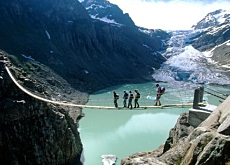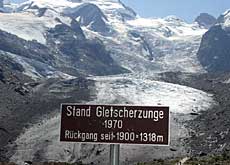The greatest alpine show on earth?

People are flocking to see global warming at work in the Swiss Alps. A rapidly melting glacier has become the latest must-see on the travel circuit.
Since the beginning of the summer, the remains of the Trift Glacier have been made more easily accessible thanks to a new cable car service and the opening of a spectacular suspension footbridge.
As I stand weak-kneed in the middle of the bridge, high above the turquoise lake formed by the melting glacier, I ponder how P.T. Barnum would promote this natural spectacle.
I convince myself the American showman who billed his circus as “the greatest show on earth” would trumpet, “Come and see once mighty glaciers vanish before your very eyes.”
“It’s melting so rapidly that you can almost see it lose its hold on the rock. It’s just a question of time before the entire lower half breaks off,” says Walter Brog.
Brog is no modern day Barnum and not prone to exaggeration. But he has watched helplessly as this glacier has retreated several hundred metres over the past decade.
What is left is a sheet of ice clinging for dear life to a steep mountainside; the melt water forming an expanding lake where the tongue once bridged the top of a gorge.
Missing link
Until about five years ago, alpinists crossed the tongue as the easiest way to get from one side of the mountain to the other on their way up to a hut perched above the glacier.
As the hut’s business manager, it was Brog who initiated the project to build the suspension bridge to replace the missing glacial link.
The project took shape within a matter of months, and a bridge designed by Swiss engineers for use in Nepal was deployed for the first time in the Alps.
It has become an attraction itself, billed as the longest of its kind in Europe at more than 100 metres, and appears to levitate above the lake.
Many hikers come only as far as the bridge in order to walk over it and back again, take a few pictures and of course, to admire the breathtaking effects of global warming.
Cable car
Coinciding with the bridge inauguration, the local hydroelectricity company opened its transport cable car to the public, which has considerably shortened the hike to the bridge and glacier.
What once took 3.5 hours can now be done by sturdy-shoed and fit walkers in a little over an hour.
The cable car was built about 50 years ago to transport construction materials to the site of a reservoir a few hundred metres below the glacier, which is fed by mountain streams and runoff water from the ice sheet. This reservoir mostly traps water now spilling over from the glacial lake before it is funnelled six kilometres through the mountainside to the power plants.
Ernst Baumberger, head of communications for Grimsel Power, says the heightened interest in the dramatic meltdown of the Trift Glacier has provided his company with an opportunity to promote the benefits of hydroelectricity.
“It’s good for our image since we can show people how hydroelectricity is produced in alpine areas,” Baumberger explains. “Hydroelectricity is renewable, and causes no pollution.”
Fatal attraction
Before this year, only about 1,500 people set out on foot each summer to discover the high alpine region surrounding the glacier. But with the opening of the cable car and with the irresistible attraction of a disappearing glacier and spectacular suspension bridge, the same number of people are now making the journey each week.
“The glaciers in the Alps are melting,” Baumberger continues. “We have almost too much water in summertime and that’s a problem. The advantage of glaciers is that they store water, regulating the circulation. If the glaciers disappear, the water will not be impeded on its way down the slope and that will cause flooding in the lowlands.”
“If you want to replace the function of a glacier, you have to build a dam, which can technically regulate the flow of water,” he adds.
The Trift Glacier’s claim to fame has been the speed of its retreat.
“We want to show visitors the effects of global warming,” says Brog. “We eventually want to provide them with information on glaciology and geology, and to raise awareness of the problem of global warming.”
In a worst case scenario, scientists say a one-million-cubic-metre chunk of ice could break off and crash into the lake, causing a tidal wave to rush down the valley.
A sobering thought as we stand in the middle of the bridge bracing ourselves against a strong wind while storm clouds gather above the peaks.
The hike to the Trift Glacier can be done as a day trip from the Bernese Oberland resort of Meiringen.
There is a regular train-bus service from Meiringen to the cable car station.
It’s a ten-minute cable car ride followed by a 1-1.5-hour uphill hike to the bridge and glacial lake.
The Windegg mountain hut, which provides accommodation, food and drink, is a 20-minute walk from the bridge, and can be visited on a round trip back to the cable car.
The Trift hut above the glacier takes 3 hours to reach along a narrow, steep path.

In compliance with the JTI standards
More: SWI swissinfo.ch certified by the Journalism Trust Initiative



You can find an overview of ongoing debates with our journalists here. Please join us!
If you want to start a conversation about a topic raised in this article or want to report factual errors, email us at english@swissinfo.ch.